- 8 channels
- 20MHz bandwidth
- Low sine and pulse distortion
- High-performance arbitrary waveform generator
- Split-screen waveform viewing
- SuperSpeed USB 3.0 interface
- Advanced digital triggers
- 12 bit resolution
- 256 MS buffer memory
- Serial bus decoding
Typical Applications
- Single- and 3-phase power transmission analysis
- Complex embedded system development
- Multi-sensor systems
- DC power supply sequencing
- Drives and controls
- Automotive system design, debug and validation
- 7.1 and 5.1 audio system measurements
8 channel oscilloscope
The PicoScope 4824 is a low cost, portable solution for multi-input applications.
Combining high resolution technology with 256 Msamples buffer memory, powerful debug tools and a built-in arbitrary waveform generator, the PicoScope 4824 is the ideal oscilloscope for precise measurements and rapid debug. Tools such as Mask Limit Testing, Serial Bus Decoding, Advanced Digital Triggers and Persistence Mode help to track problems for rapid troubleshooting. Waveforms are captured in high resolution, making it easy to distinguish signal from noise to ease debug and analysis.


Applications - Power Measurements
The PicoScope 4824 is ideal for making a range of power measurements on high voltages and currents and low-voltage control signals. For the best results, use a Pico differential voltage probe (TA041 or TA057) in combination with a current clamp (TA167). To improve the efficiency and reliability of power designs, the scope can display and analyze standby power dissipation, inrush current and steady-state power consumption. PicoScope's built-in measurements and statistics of parameters such as true RMS, frequency, peak-to-peak voltage and THD allow accurate analysis of power quality.
Nonlinear loads and modern power-conversion equipment produce complex waveforms with significant harmonic content. These harmonics reduce efficiency by causing increased heating in equipment and conductors, misfiring in variable speed drives, and torque pulsations in motors. The 12-bit PicoScope 4824 has the precision to measure distortion typically up to the 100th harmonic. On the supply side, power quality issues such as sags and dips, swells and spikes, flicker, interruptions and long-term voltage and frequency variations can also be checked for regulatory compliance.
Data Acquisition
With 256 Msamples of buffer memory the scope can capture over 5 minutes of continuous 50/60 Hz waveform data with high timing resolution. Using the Software Development Kit (SDK) you can write custom applications with storage limited only by the PC hard disk size.Applications - Complex embedded systems
When debugging an embedded system with a scope, you can quickly run out of channels. You may need to look at an I2C or SPI bus at the same time as multiple power rails, DAC outputs and logic signals. With eight channels, the PicoScope 4824 can cope with all of this. Choose whether to decode up to eight serial buses, with analog waveforms and decoded data both visible, or a combination of serial buses and other analog or digital signals. PicoScope provides advanced triggering on all channels, so you can search for runt pulses, drop-outs and noise as well as looking for data patterns using the 4-input Boolean logic trigger.
8 Channel PC Oscilloscope Hardware Features
High Signal Integrity
Most oscilloscopes are built down to a price. PicoScopes are built up to a specification.
Careful front-end design and shielding reduces noise, crosstalk and harmonic distortion, meaning we are proud to publish the specifications for our scopes in detail. Decades of oscilloscope design experience can be seen in both improved pulse response and bandwidth flatness, and low distortion. The scope features 12 input ranges from ±10 mV to ±50 V full scale, a huge dynamic range, and 70 dB SFDR. The result is simple: when you probe a circuit, you can trust in the waveform you see on the screen.
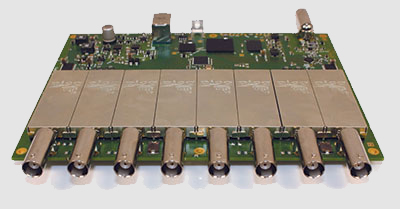
Digital triggering
Most digital oscilloscopes still use an analog trigger architecture based on comparators. This can cause time and amplitude errors that cannot always be calibrated out. The use of comparators often limits the trigger sensitivity at high bandwidths and can also create a long trigger re-arm delay.
For over 20 years Pico have been pioneering the use of full digital triggering using the actual digitized data. This reduces trigger errors and allows our oscilloscopes to trigger on the smallest signals, even at the full bandwidth. All triggering is digital, resulting in high threshold resolution with programmable hysteresis and optimal waveform stability.
The reduced re-arm delay provided by digital triggering, together with segmented memory, allows the capture of events that happen in rapid sequence. At the fastest timebase, rapid triggering can capture a new waveform every 3 microseconds until the buffer is full. The mask limit testing function helps to detect waveforms that fail to meet your specifications.
-
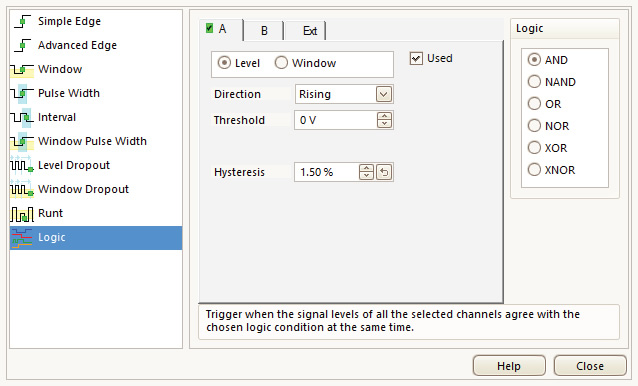 mouseover or touch for larger image
mouseover or touch for larger image
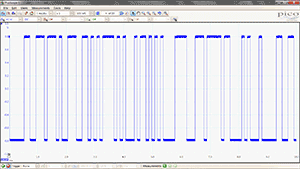
Hardware acceleration ensures fast screen update rates even when collecting 100,000,000 samples per waveform
Advanced triggers
As well as the standard range of triggers found on most oscilloscopes, the PicoScope 4824 has a comprehensive set of advanced triggers built in to help you capture the data you need. These include pulse width, windowed, and dropout triggers to help you find and capture your signal quickly.
Hardware acceleration
On some oscilloscopes, enabling deep memory has a penalty: the screen update rate slows down and the controls become unresponsive as the processor struggles to cope with the amount of data. Thanks to the hardware acceleration inside PicoScope deep-memory oscilloscopes, you can collect waveforms containing hundreds of millions of samples while keeping fast screen update rates and a responsive user interface.
Dedicated hardware inside the oscilloscope processes multiple streams of data in parallel to construct the waveform that will be displayed on the screen. This is done far faster than any PC processor could manage, and together with USB 3.0 SuperSpeed data transfer eliminates any bottlenecks between the oscilloscope and the PC.
For example, the scope may be set to capture 10,000,000 samples but the PicoScope display window may be only 1000 pixels wide. In this case, the scope intelligently compresses the data into 1000 blocks of 10,000 samples each. Unlike simple decimation, which throws away most of the data, PicoScope hardware acceleration guarantees that you see any high-frequency details such as narrow glitches, even when the display is zoomed out.
Store up to 10,000 waveforms in the buffer
Ever spotted a glitch on a waveform, but by the time you've stopped the scope it has gone? With PicoScope you no longer need to worry about missing glitches or other transient events. Depending on the settings, PicoScope can store up to the last ten thousand waveforms in its buffer.

Arbitrary Waveform and Function Generators
The PicoScope 4824 has a built-in low-distortion, 80 MS/s, 14 bit arbitrary waveform generator (AWG), which can be used to emulate missing sensor signals during product development, or to stress test a design over the full intended operating range. Waveforms can be imported from data files or created and modified using the graphical AWG editor included.
A function generator is also included, with sine, square, and triangle waves up to 1 MHz, along with DC level, white noise, and many more standard waveforms. As well as level, offset and frequency controls, advanced options allow you to sweep over a range of frequencies. Combined with the spectrum peak hold option, this creates a powerful tool for testing amplifier and filter responses.
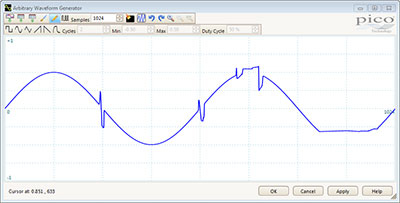
Spectrum Analyser
With the click of a button, you can open a new window to display a spectrum plot of selected channels up to the full bandwidth of the oscilloscope. A comprehensive range of settings gives you control over the number of spectrum bands, window types and display modes.
A comprehensive set of automatic frequency-domain measurements can be added to the display, including THD, THD+N, SINAD, SNR and IMD. You can even use the AWG and spectrum mode together to perform swept scalar network analysis.
PicoScope performance and reliability
With over 20 years' experience in the test and measurement industry, we know what's important in an oscilloscope.
The PicoScope 4824 delivers value for money by including a wide range of high-end features as standard. The PicoScope 6 software includes options such as serial decoding and mask limit testing, and new functionality is regularly delivered through free upgrades to ensure that your device does not quickly become outdated. All Pico Technology devices are optimized with the help of feedback from our customers.
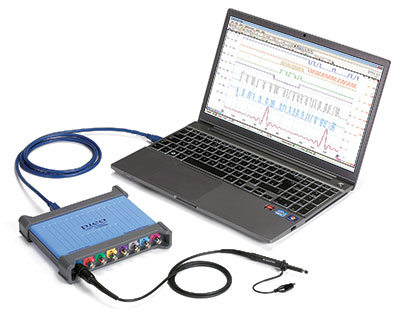
USB connectivity

The SuperSpeed USB 3.0 connection not only allows high-speed data acquisition and transfer, but also makes printing, copying, saving, and emailing your data from the field quick and easy. USB powering removes the need to carry around a bulky external power supply, making the kit even more portable for the engineer on the move.
The PicoScope 4824 is also backward compatible with older USB 2.0 devices.
High-end Features as Standard
Buying a PicoScope is not like making a purchase from other oscilloscope companies, where optional extras considerably increase the price. With our scopes, high-end features such as resolution enhancement, mask limit testing, serial decoding, advanced triggering, automatic measurements, math channels, XY mode, segmented memory, and a signal generator are all included in the price.
To protect your investment, both the PC software and firmware inside the scope can be updated. Pico Technology have a long history of providing new features for free through software downloads. We deliver on our promises of future enhancements year after year, unlike many other companies in the field. Users of our products reward us by becoming lifelong customers and frequently recommending us to their colleagues.
| Oscilloscope - Vertical | |
|---|---|
| Input channels | 8 |
| Connector type | BNC, 20 mm spacing |
| Bandwidth (-3 dB) | 20 MHz (50 mV to 50 V ranges), 10 MHz (10 mV and 20 mV ranges) |
| Rise time (calculated) | 17.5 ns (50 mV to 50 V ranges), 35.0 ns (10 mV and 20 mV ranges) |
| Vertical Resolution | 12 bits |
| Enhanced Vertical Resolution | 16 bits |
| Input Ranges | ±10 mV to ±50 V full scale, in 12 ranges |
| Input Sensitivity | 2 mV/div to 10 V/div (10 vertical divisions) |
| Input Coupling | AC/DC |
| Input Characteristics | 1 MΩ in parallel with 19 pF |
| DC accuracy | ±1% of full scale ±300 μV |
| Analogue offset range (vertical position adjustment) |
±250 mV (10 mV to 500 mV ranges) ±2.5 V (1 V to 5 V ranges) ±25 V (10 V to 50 V ranges) |
| Overvoltage Protection | ±100 V (DC + AC peak) |
| Oscilloscope - Horizontal (timebase) | |
|---|---|
| Maximum Sampling Rate (real-time) | 80 MS/s (1 to 4 channels in use), 40 MS/s (5 to 8 channels in use) |
| Maximum Sampling Rate (USB streaming) | 10 MS/s using PicoScope 6 software, 80 MS/s per channel using supplied API. 160 MS/s total across all channels. (PC dependent) |
| Timebase Ranges (real time) | 20 ns/div to 5000 s/div |
| Buffer Memory(shared between active channels) | 256 MS |
| Buffer Memory (streaming mode) | 100 MS in PicoScope software. Up to available PC memory when using supplied API |
| Waveform Buffer | 10,000 segments |
| Maximum Waveforms Per Second | 25,000 wfm/s (PC dependent) |
| Timebase Accuracy | ±20 ppm (+5 ppm/year) |
| Sample Jitter | 25 ps RMS typical |
| Dynamic Performance (typical) | |
|---|---|
| Crosstalk (full bandwidth) | 20 000:1, DC to 20 MHz |
| Harmonic Distortion | < −60 dB, 10 mV range, < −70 dB, 20 mV and higher ranges |
| SFDR | > 60 dB, 20 mV and 10 mV ranges, > 70 dB, 50 mV and higher ranges |
| Noise | 45 μV RMS on 10 mV range |
| ADC ENOB | 11.3 bits |
| Pulse Response | < 1% overshoot |
| Bandwidth Flatness (at scope input) | DC to full bandwidth (+0.2 dB, −3 dB) |
| Triggering | |
|---|---|
| Source | Channels A to H |
| Trigger Modes | None, auto, repeat, single, rapid (segmented memory) |
| Advanced Trigger Types |
Edge: rising, falling or either edge; adjustable hysteresis Pulse width: negative or positive pulse; wider or narrower than a specified width, or inside/outside a range of widths Window: entering or leaving a voltage range Window pulse width: signal is inside or outside a voltage range for a set time Dropout: inactivity over a user–defined time interval Window dropout: signal does not enter or exit a voltage range for at least a set time Interval: time between two edges is greater or less than a set time, or inside/outside a time range Logic level: arbitrary logic state of up to four selected input channels Runt pulse: crosses one threshold but not the other |
| Trigger Sensitivity | Digital triggering provides 1 LSB accuracy up to full bandwidth |
| Maximum Pre-trigger Capture | Up to 100% of capture size |
| Maximum Post-trigger Delay | Up to 4 billion samples |
| Trigger Re-arm Time | < 3 μs on fastest timebase |
| Maximum Trigger Rate | Up to 10 000 waveforms in a 30 ms burst |
| Advanced Digital Trigger Levels | All trigger levels, window levels and hysteresis values settable with 1 LSB resolution across input range |
| Advanced Digital Trigger Time Intervals | All time intervals settable with 1 sample resolution from 1 sample (minimum 12.5 ns) up to 4 billion sample intervals |
| Function Generator | |
|---|---|
| Standard output signals | Sine, square, triangle, DC voltage, ramp, sinc, Gaussian, half-sine, white noise, PRBS |
| Standard signal frequency | DC to 1 MHz |
| Sweep modes | Up, down, dual with selectable start/stop frequencies and increments |
| Triggering | Can trigger a counted number of waveform cycles or sweeps (up to 1 billion) from the scope trigger or manually from software. |
| Output frequency accuracy | ±20 ppm |
| Output frequency resolution | < 20 mHz |
| Output voltage range | ±2 V |
| Output voltage adjustments | Signal amplitude and offset within ± 2V range. Adjustable in approx 300 μV steps. |
| Amplitude flatness | < 0.5 dB to 1 MHz typical |
| DC accuracy | ±1% of full scale |
| SFDR | 87 dB typical |
| Output characteristics | Rear panel BNC, 600 Ω output impedance |
| Overvoltage Protection | ±10 V |
| Arbitrary Waveform Generator | |
|---|---|
| Update Rate | 80 MS/s |
| Buffer Size | 16 kS |
| Resolution | 14 bits |
| Bandwidth | 1 MHz |
| Rise Time (10% to 90%) | 150 ns |
| Spectrum Analyser | |
|---|---|
| Frequency Range | DC to 20 MHz |
| Display Modes | Magnitude, average, peak hold |
| Windowing Functions | Rectangular, Gaussian, triangular, Blackman, Blackman-Harris, Hamming, Hann, flat-top |
| Number of FFT Points | Selectable from 128 up to 1 million in powers of 2 |
| Math Channels | |
|---|---|
| Functions | -x, x+y, x-y, x*y, x/y, x^y, sqrt, exp, ln, log, abs, norm, sign, sin, cos, tan, arcsin, arccos, arctan, sinh, cosh, tanh, freq, derivative, integral, min, max, average, peak, delay |
| Operands | Input channels A to H, reference waveforms, time, π |
| Automatic Measurements | |
|---|---|
| Scope Mode | AC RMS, true RMS, cycle time, DC average, duty cycle, falling rate, fall time, frequency, high pulse width, low pulse width, maximum, minimum, peak to peak, rise time, rising rate. |
| Spectrum Mode | Frequency at peak, amplitude at peak, average amplitude at peak, total power, THD %, THD dB, THD+N, SFDR, SINAD, SNR, IMD |
| Statistics | Minimum, maximum, average and standard deviation |
| Serial Decoding | |
|---|---|
| Protocols | CAN, LIN, I2C, I2S, UART/RS-232, SPI, FlexRay |
| Mask Limit Testing | |
|---|---|
| Statistics | Statistics Pass/fail, failure count, total count |
| Software | |
|---|---|
| PicoScope 6 |
PicoScope 6 is your complete test and measurement lab in one application. Features include: Capture modes: oscilloscope, spectrum and persistence. Channel maths: calculate the sum, difference, product, inverse or create your own custom function using standard arithmetic, exponential and trigonometric functions. Mask limiting testing: pass/fail, failure count, total count. Serial Decoding: decode data from a serial bus such as I²C. Automated measurements Scope mode: AC RMS, true RMS, cycle time, DC average, duty cycle, falling rate, fall time, frequency, high pulse width, low pulse width, maximum, minimum, peak-to-peak, rise time and rising rate. Spectrum mode: frequency at peak, amplitude at peak, average amplitude at peak, total power, total harmonic distortion (THD % and THD dB), total harmonic distortion plus noise (THD+N), spurious-free dynamic range (SFDR), signal+noise+distortion to signal+noise ratio (SINAD), signal to noise ratio (SNR) and intermodulation distortion (IMD). Export data formats: comma separated values (CSV), tab delimited (TXT), Windows bitmap (BMP), graphics interchange format (GIF), portable network graphics (PNG), MATLAB 4 format (MAT). Operating systems supported: Microsoft Windows XP (SP3) to Windows 8 (stable software), Linux and OS X for Mac (beta software). More informaion about PicoScope 6 |
| Linux drivers | Linux Software & Drivers for PicoScope 4824 |
| Software development kit | A growing collection of drivers and example code for various programming languages. |
| PC Requirements | |
|---|---|
| Minimum |
Processor: 1 GHz. Memory: 512 MB. Free disk space: 32-bit: 600 MB, 64-bit: 1.5 GB. Operating system: 32 or 64-bit edition of Microsoft Windows XP (SP3), Vista, Windows 7 or Windows 8 (not Windows RT). Beta software: Linux Debian, OpenSUSE and Fedora derived distributions, OS X (Mac). Ports: USB 2.0 compliant port. |
| Recommended |
Processor: 1 GHz. Memory: 512 MB. Free disk space: 32-bit: 850 MB, 64-bit: 2 GB. Operating system: 32 or 64-bit edition of Microsoft Windows XP (SP3), Vista, Windows 7 or Windows 8 (not Windows RT). Beta software: Linux Debian, OpenSUSE and Fedora derived distributions, OS X (Mac). Ports: USB 3.0 compliant port. |
| Environmental | |
|---|---|
| Operating Environment Temperature Range Humidity |
0 to 45 °C (20 to 30 °C for quoted accuracy) 5 to 80% RH, non-condensing |
| Storage Environment Temperature Range Humidity |
-20 to +60 °C 5 to 95% RH, non-condensing |
| Physical Properties | |
|---|---|
| Dimensions | 190 x 170 x 40 mm |
| Weight | < 0.55 kg |
| General | |
|---|---|
| What's in the box? | USB 3.0 cable, user manuals, software CD-ROM and a double-headed USB 2.0 cable |
| PC connectivity | SuperSpeed USB 3.0 (USB 1.1 and USB 2.0 compatible) |
| Power Requirements | Powered from single USB 3.0 port or two USB 2.0 ports |
| Compliance | RoHS compliant, WEEE, and LVD compliant. Tested to meet EN61326-1:2006 and FCC Part 15 Subpart B. |
